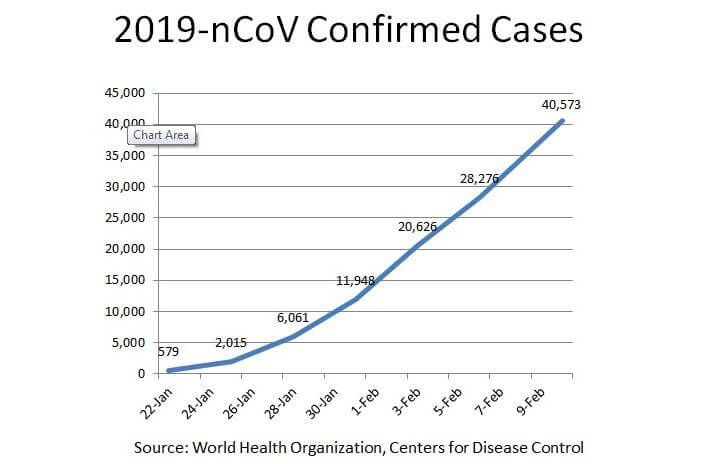To access local coronavirus/COVID-19 coverage on the Herald website, click here.
To get local coronavirus-related updates delivered daily to your inbox with Herald Daily Headlines, sign up now.
To get important news developments anytime, anywhere, with Herald mobile alerts, sign up now.
COURT HOUSE – A Centers for Disease Control and Prevention (CDC) threat assessment states that the “potential public health threat posed by 2019 novel coronavirus (2019-nCoV) is high, both globally and to the U.S.” The statement continues that for the “general American public, who are unlikely to be exposed to the virus, the immediate health threat is low.”
The state Health Department has underscored the CDC’s conclusions, noting that no confirmed cases of the virus have been found in the state.
Four individuals from a cruise ship docked in New Jersey were suspected cases, but have been ruled out following testing. One passenger, at Newark International Airport, was subjected to mandatory quarantine.
Gov. Phil Murphy established a state task force in order to ensure that the state has “strong preparedness protocols in place.” Local health professionals have attended a statewide workshop on the virus.
According to Rosemary Dunn, chief nursing officer, Cape Regional Medical Center, “Cape Regional Medical Center has developed and implemented protocols, in conjunction with the local and state departments of health, for evaluating patients for the novel coronavirus.”
Dunn added that international travelers who present with signs and symptoms of a fever, cough and shortness of breath will “be asked to put on a mask and will be taken directly to an isolation room. Staff will wear personal protective equipment, which includes a mask, eye protection, gown and gloves. Once a patient has been identified, the local health department will be contacted for further instructions and guidance.”
Acting quickly, CDC officials have developed and begun distributing test kits to laboratories across the nation. Prior to the development of the kits, only the CDC was able to perform the necessary tests to confirm a case of the virus.
Number of Cases
Cases of the virus are multiplying rapidly. The World Health Organization (WHO) Feb. 6 stated that the virus had not peaked. The virus is largely confined to China, with 99% of confirmed cases in that country.
Patient zero, used to refer to the person identified as the first carrier of a communicable disease in an outbreak of related cases, presented with symptoms of the virus, in Wuhan, China, in December 2019. Wuhan is the capital city of the central China province of Hubei.
Wuhan is a city of 11 million people. Transportation to and from the city has been suspended.
Thailand reported the first international case of the virus Jan. 13. Later that day, reports of individuals infected with 2019-nCoV were noted in Japan and South Korea. The following day, cases were reported in the U.S. and Taiwan.
The first cases were linked to a large seafood and animal market in Wuhan. Subsequent cases showed person-to-person contact could spread the disease.
The CDC established a 2019-nCov Incident Management System Jan. 7. Two weeks later, an Emergency Operations Center opened, dedicated to the virus risk. Travel guidelines were issued.
The U.S. suspended entry Feb. 2 to foreign nationals who have been in China in the past 14 days. U.S. citizens returning from the area are subject to health monitoring and possible quarantine.
The virus has spread so rapidly, especially in China, that Johns Hopkins researchers at the Center for System Science and Engineering have developed a real-time reporting system on confirmed cases and deaths.
A WHO bulletin listed 2,000 confirmed cases and 56 deaths Jan. 26. By Feb. 7, the journal Nature listed 31,161 cases and 630 deaths. As of Feb. 10, reported cases stand at 40,651, with 910 deaths.
The Feb. 10 statistics from the WHO and the CDC show that about 18% of those infected are listed in serious or critical condition. The other 82% are presenting what are termed mild infections.
The new totals for 2019-nCoV mean that the virus has killed more people than Severe Acute Respiratory Syndrome (SARS) did in 2003. Almost 96% of the deaths have occurred in China.
At present, confirmed cases of the virus have been located in 28 countries, including the U.S.
The countries impacted include those as disparate as Sweden, Canada and the United Arab Emirates.
In the U.S., the CDC lists 12 confirmed cases in six states. To date, 337 people have been investigated for the virus, 225 have tested negative, 12 cases have been confirmed and 100 cases are pending testing results. The 337 who were under investigation were spread over 36 states and territories. No deaths from the virus have been recorded in the U.S.
What is Coronavirus?
Coronaviruses are a family of viruses infecting humans and animals. The CDC lists seven coronaviruses that infect people; most not causing severe health issues.
The virus is common in camels, cattle, cats and bats. It is rare for the coronavirus to bridge the gap between animals and humans.
The virus can cause medical problems ranging from mild flu-like symptoms to death. Serious illnesses are rare.
The WHO says that older people and those with pre-existing medical conditions are the most vulnerable to the virus. So far, the mortality rate from 2019-nCoV infections is lower than was experienced with SARS. While WHO stated that an overall mortality rate would not be known for some time, it appears that a smaller percentage of those infected are succumbing to the disease compared to the rate seen during the SARS outbreak.
SARS and MERS
The coronaviruses that have most negatively impacted human beings appear to have originated in animals, and made the leap from an animal to a human host. Gene sequencing has demonstrated that the 2019-nCoV is related to SARS and Middle East Respiratory Syndrome (MERS).
SARS has been linked to civets, a catlike mammal resembling a raccoon. A ban on importing civets into the U.S. is in effect 17 years after the SARS outbreak.
The first case of SARS was most likely a resident of Guangdong Province, in China, in November 2002. The virus jumped to Hong Kong the following February.
From there it traveled to Singapore, Hanoi and Toronto. International efforts to isolate and quarantine people with the virus resulted in announcing the global SARS outbreak contained July 5, 2003.
By December 2003, health officials reported that 8,096 people had been infected with SARS in 26 countries, with 774 deaths. The CDC said that the U.S. experienced eight confirmed infections, with 19 others probable. There were no deaths.
MERS probably made the transition from camels to people, in Saudi Arabia, in 2012. Once the transition was accomplished, MERS, like SARS, showed the ability for transmission from human to human.
Estimates are that MERS infected 2,521 people, and was responsible for 919 deaths. All cases of MERS were linked to the Arabian Peninsula.
The largest outbreak of the MERS virus outside of that area was in the Republic of Korea in 2015. That outbreak was linked to a traveler returning from the Arabian Peninsula.
Two cases were confirmed, in the U.S., in 2014, related to recent travel to Saudi Arabia.
2019-nCoV
The novel (new) coronavirus is of the same family as SARS and MERS. The WHO convened a meeting of international health experts Feb. 11 and Feb. 12 to expand plans for containing the virus.
The 12 confirmed cases in the U.S. include one in Boston, two in Chicago, one in Madison, Wis., one in Seattle, Wash., one in Tempe, Ariz. and six in California (four near San Francisco and two near Los Angeles).
In a release, New Jersey Health Commissioner Judith M. Persichilli said, “The risk to New Jersey remains low, and our level of preparedness is high.”
Those wishing to track the spread of the virus on the Johns Hopkins visualization system can go to http://bit.ly/2OIDPyz.
To contact Vince Conti, email vconti@cmcherald.com.
Wildwood Crest – Several of Donald Trump’s Cabinet picks have created quite a bit of controversy over the last few weeks. But surprisingly, his pick to become the next director of the FBI hasn’t experienced as much…








